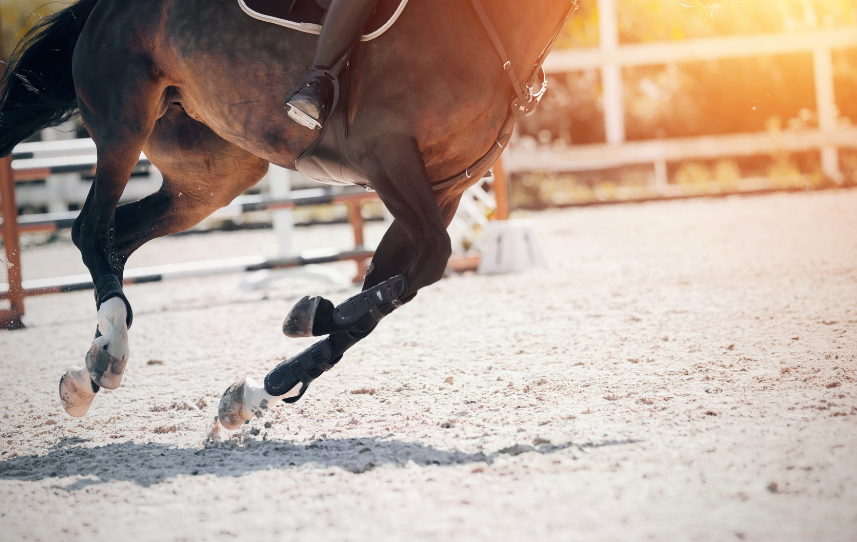
Fun Dressage Exercises for Showjumpers to Sharpen Their Skills
Share
For many showjumpers, dressage can feel like the less thrilling sibling of their adrenaline-fueled sport. However, dressage offers an essential foundation for improving your horse’s responsiveness, balance, and precision, which are qualities that directly benefit performance in the jumping arena.
The good news? Dressage doesn’t have to be boring! By incorporating targeted, fun exercises into your routine, you can enhance your horse’s athleticism while keeping both of you engaged.
Here are five exercises that blend the artistry of dressage with the dynamic needs of showjumping:
1. Pole Work with Transitions
This exercise combines precision with fun, helping you improve rhythm, balance, and responsiveness.
Setup:
- Lay a series of poles on the ground, spaced evenly for trot or canter strides.
- Start with four to six poles at a comfortable distance for your horse.
How to Ride It:
- Approach the poles at a trot, focusing on maintaining a steady rhythm.
- After crossing the last pole, transition smoothly into a canter, maintaining forward energy and balance.
- Repeat the exercise in reverse: canter over the poles, then transition to trot.
Why It Works:
Transitions teach your horse to stay attentive to your aids, improving adjustability, which is a crucial skill for finding the perfect takeoff spot in a jump-off. The poles encourage your horse to lift their legs and engage their core, promoting better movement.
2. Serpentine Patterns with Lateral Work
Adding lateral movements to serpentines builds suppleness and encourages your horse to bend through their body.
Setup:
- Use a large arena and visualize or mark a serpentine pattern with three loops.
How to Ride It:
- Ride the serpentine in a trot or canter, asking for correct bend as you navigate each loop.
- On the straight portions, introduce lateral work, such as leg-yield or shoulder-in.
- Focus on smooth transitions between bending and lateral aids.
Why It Works:
This exercise improves flexibility and teaches your horse to engage their hindquarters more effectively. The fluid changes in direction mimic the quick adjustments needed in tight jumper courses.
3. Counter-Canter on a Figure-Eight
Counter-canter is an excellent way to build balance and strengthen your horse’s hind end, critical for powerful jumps.
Setup:
- Use cones or poles to mark two large circles (20 meters each) that overlap slightly, forming a figure-eight.
How to Ride It:
- Begin on a circle in a true canter.
- When crossing to the second circle, maintain the same lead, transitioning into a counter-canter.
- Complete the figure-eight, then change direction and repeat.
Why It Works:
Counter-canter enhances your horse's coordination and ability to stay balanced on a less natural lead. This improved balance translates to tighter turns and smoother lines during a jumping course.
4. Spiral In and Out on a Circle
This exercise develops suppleness, balance, and engagement of the hindquarters.
Setup:
- Visualize or mark a 20-meter circle in the arena.
How to Ride It:
- Start on the large circle at a trot or canter.
- Gradually spiral inward to a 10-meter circle by applying gentle inside leg and rein aids.
- Once you reach the smaller circle, spiral outward, encouraging your horse to stretch and maintain rhythm.
Why It Works:
Spiraling improves lateral flexibility and helps your horse learn to move off your leg, both critical for negotiating sharp turns in jumping. The gradual changes in size also develop strength and rhythm.
5. Walk-to-Canter Transitions on a Straight Line
This advanced exercise sharpens your horse’s responsiveness and ability to transition smoothly between gaits.
Setup:
- Use a straight path along the long side of the arena or down the centerline.
How to Ride It:
- Ride forward at a collected walk.
- Ask for a canter transition with clear, concise aids.
- After a few strides, transition back to the walk without losing balance or forward momentum.
- Repeat several times, focusing on smooth, crisp transitions.
Why It Works:
This exercise strengthens your horse’s hindquarters and enhances their responsiveness to aids. A powerful, controlled canter from the walk is invaluable when preparing for tight approaches to jumps.
How These Exercises Benefit Showjumpers
Dressage exercises like these lay the groundwork for success in the showjumping arena. Here’s how:
- Enhanced Precision: Better communication and refined aids mean more precise turns and approaches.
- Improved Balance: Exercises like counter-canter and spiraling help your horse stay balanced, even during sharp turns.
- Increased Adjustability: The transitions and lateral work improve your horse's ability to adjust stride length and pace, a key skill for navigating jump-offs.
- Stronger Hindquarters: Many dressage movements build the strength needed for powerful takeoffs and landings.
Making Dressage Fun for Showjumpers
To keep things engaging, vary your routine and reward your horse generously for their efforts. Use cones, poles, or creative setups to simulate the challenges of a jumping course. Remember, the goal isn’t perfection - it’s progress.
As a showjumper, incorporating dressage doesn’t just improve your horse's skills; it also deepens your partnership and your own riding skills, making every ride more rewarding.


